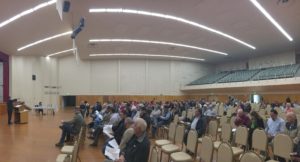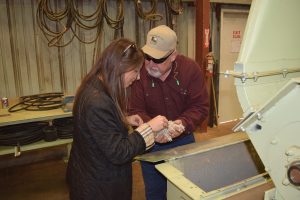Earlier this week, the Department of Water Resources (DWR) hosted a public meeting to discuss a newly released draft document regarding the Sustainable Groundwater Management Act (SGMA). The workshop focused on a newly released Best Management Practices (BMP) draft document. The BMP document primarily focuses on basin modeling, as well as developing and maintaining basin-wide monitoring networks. The modeling and monitoring are both important to the long term effectiveness of the SGMA program. The basin modeling will show the layout of the basin as well as the various sources that provide and take water in that specific area, and the monitoring will be able to show changes to the basin in real time. The Association has submitted comments on the draft document, encouraging DWR to take a synergistic approach to monitoring with other programs that are already in place. Programs such the California Statewide Groundwater Elevation Monitoring (CASGEM) and the Irrigated Lands Regulatory Program (ILRP) are already monitoring water levels and water quality. Utilizing these pre-existing programs help reduce cost of installing monitoring wells, and will also minimize the potential for collecting duplicative data. It is our understanding that the development of these BMP’s will not create any additional regulatory requirements in the monitoring for these programs; they will work in coordination with what is already required. DWR only wants to utilize monitoring sites that are already in place and functional. If you would like a link for the draft BMP’s or an email to submit comments, please feel free to contact Chris McGlothlin with the Association.
NEWS & ISSUES
Growers Gather in Tulare to Oppose DPR School Regulation
Over the past week the California Cotton Ginners and Growers Association (CCGGA) has been calling upon our grower community and last night they answered. Joining CCGGA Director of Regulatory Affairs Jodi Raley, nearly 20 growers gathered to provide public comment opposing the Department of Pesticide Regulation’s (DPR) proposed draft rule that would prohibit many applications within a quarter mile of a school site and day care facility. Additionally it would could cause growers to provide an annual notification to the school site of all potential applications they expect to make over the next year as well as a 48-hour notification to the school site providing a 12-hour window of when and where the application will be made. CCGGA provided public comment adamantly opposing the regulation as it not only limits the flexibility that growers need to make real-time decision for applications, but additionally the regulation only further will propagate fear, misunderstanding and undue concern surrounding crop protection tools and the method of applications. Comments from the grower community included points of how it will impact their operation and limit their ability to produce, however most importantly growers shared their relationship with adjacent schools and how they take pride in the communication, coordination and trust that has been developed for years. Many shared of how their children and now grandchildren attend those very schools so as responsible stewards of the land it is their duty to protect human health when growing their crop. These comments and others were critical in the public hearing process as the activists group present at last night’s meeting was requesting an extension of the regulation to a 1-mile buffer zone enforced 24/7. There is one public hearing left on this issue schedule for Thursday, Dec. 1 at 6 p.m. with written comments being accepted until COB Dec. 9, 2016. If you would like more information or would like to sign on to our opposition letter you can do that at https://www.ccgga.org/industry-call-to-action/.
California Democrats on the Verge of Supermajority
With the nation still celebrating, or protesting, the results of this year’s election, outcomes for some key Assembly and Senate races are still being tallied. A final count is being reviewed to determine if Democrats have secured a supermajority in both the Assembly and Senate. On the Assembly side, Democrats are on the verge of picking up the two necessary seats to give them a two-thirds supermajority. With a return victory for Democrat Al Muratuschi in District 66 (Torrance), District 65 (Fullerton) is also showing Democrat Sharon Quirk-Silva ahead of her Republican challenger Young Kim by a slim margin. Democratic Challenger Sabrina Cervantes is also leading incumbent Republican Assembly Member Eric Linder in District 60’s (Corona) race.
The supermajority is too early to call on the Senate side, but Senate Dems have held on to all of their current seats. They only need to pick up one more additional seat to gain the supermajority. Ballots are still being calculated in the race to fill former Republican Minority Leader Bob Huff’s seat for District 29 (Diamond Bar). Republican nominee Ling Ling Chan holds a 1.8% lead over Democratic Challenger Josh Newman.
In other election news, Governor Brown secured a small victory for his Twin Tunnels project with the defeat of Proposition 53. Prop 53 would have required the project to go before a vote of the people before the building process could begin. Republicans also scored a small victory with the passage of Proposition 54 which requires all legislation to be in print 72 hours before it is voted on. If you have any other questions on any other propositions or races, please feel free to contact us.
State Legislature Ready to Push New $7.4 Billion Transportation Bill
In an effort almost a year in the making, the Governor and the state legislature are getting ready to move a $7.4 billion transportation bill to address deferred maintenance on the state highway system and local street and road system. They will fund this bill by increasing fuel taxes, levying an additional new motor vehicle tax and increases annual vehicle registration fees. Proposed measures include:
- 17 cents per gallon increase in the motor vehicle fuel tax
- 30 cents per gallon increase in the diesel fuel excise tax
- Increase the sales and use tax on diesel fuel by 3.5% from the current 1.75% to 5.25%
- $38.00 increase in the annual vehicle registration fee
- A new $165.00 annual vehicle registration fee attributable to zero emission vehicles
Furthermore, moving forward these increases will be tied to the California Consumer Price Index. The bill also creates the independent Office of the Transportation General (“Independent Office”), which would be a separate governmental agency designated to oversee all state agencies expending state transportation funds, including the Department of Transportation, High-Speed Rail Authority, Department of California Highway Patrol, Department of Motor Vehicles and State Air Resources Board. The bill will alter funding allocations to the Air Resources Board by continuously appropriates 20% of the annual proceeds collected by the Air Resources Board from Cap and Trade auctions to the Transit and Intercity Rail Capitol Program and 10% of the annual proceeds to the Low Carbon Transit Operations Program. The Association will be watching and opposing this legislation. With the need for a two-thirds majority to pass tax and registration increases, it will be difficult to secure the needed republican votes in this session. If the bill is not passed during the special session, but the democrats gain a super majority in the assembly and senate, we can anticipate an attempt to pass a similar transportation bill next session. Stay tuned!
CCGGA Opposes Air Resources Board Freight Facility Survey for 2017
The California Air Resources Board (CARB) held a public workshop yesterday to discuss “Data Collection and Freight Hub Survey” as part of CARB’s Sustainable Freight Strategy. This issue from early on has been an extreme concern of the California Cotton Ginners and Growers Associations (CCGGA) as the loose term of freight facility and warehouse/distribution center could include cotton ginning operations among other agricultural post-harvest facilities. This is critical as CARB eyes future rulemaking that, while not explicit stating it, could lead to the potential of a facility based diminishing emissions cap. Director of Regulatory Affairs Jodi Raley was among the very few participants in yesterday’s workshop and the only agricultural organization to comment on the matter. CCGGA’s comments included opposition to the survey presented as we believe the questions asked are not needed, contain sensitive information or data can be attained through CARB’s current resources. Additionally, CCGGA commented on the concern our Association has with CARB’s aggressive survey approach as it was just a month ago that the agriculture industry received the Large-Spark Ignition (aka Forklift) and Transportation Refrigeration Unit survey. CARB claims that they are still developing the definition and criteria of facilities that would be included on this survey, however they are stating they are eyeing a potential 55,000 facilities that they have identified thus far based off of tax assessor document along with aerial imaging identifying loading docks/bays. We will be following up with detailed comments and continued pressure to identify who will be targeted for this survey.
CCGGA Hosts Congressional Staff
This week the California Cotton Ginners and Growers Associations hosted Kristina Dunklin, Legislative Director for Congressman David Valadao (21st Congressional District), Jilian Plank, Legislative Director for Congressman Devin Nunes ((22nd Congressional District) and Ruth Hazdovac, Staff Assistant for Congressman Nunes. The group toured several agricultural sites with CCGGA President/CEO Roger A. Isom, CCGGA Director of Technical Services Christopher McGlothlin and Western Agricultural Processors Association (WAPA) Safety Specialist Priscilla Rodriguez. Of particular interest, the group visited County Line Gin. The purpose of the visit was to discuss implementation issues with the Food Safety Modernization Act (FSMA), in particular, the current applicability of the Preventive Controls Rule for Animal Food to a cotton gin. CCGGA is working with the National Cotton Ginners Association and the National Cotton Council along with members of Congress and the Senate to have FDA address this discrepancy.
Time for Food Facility Biennial Registration Renewal
Food facilities required to register with FDA must renew their food facility registrations this year during the period beginning on October 1, 2016 and ending on December 31, 2016. The FDA Food Safety Modernization Act (FSMA), enacted on January 4, 2011, amended the food facility registration requirements of section 415 of the Federal Food, Drug, and Cosmetic Act (FD&C Act). The registration requirements apply to domestic and foreign food facilities that manufacture, process, pack, or hold food for human or animal consumption in the United States. FSMA amended section 415 of the FD&C Act to provide that food facilities required to register with FDA must renew their registrations with FDA every other year, during the period beginning on October 1 and ending on December 31 of each even-numbered year. At this time, the updated renewal form has not been published and renewal is only available online through FDA’s website, please click on the following link: http://www.fda.gov/Food/GuidanceRegulation/FoodFacilityRegistration/default.htm?source=govdelivery&utm_medium=email&utm_source=govdelivery
WAPA will continue its focus and ongoing effort to bring all hullers, into the “Farm” definition regardless of ownership status, and subsequently under the Produce Safety Rule. There may be an opportunity to de-register your facility in the near future. If you have any questions please first reach out to President/CEO Roger Isom or Safety Specialist Priscilla Rodriguez at (559) 455-9272.
Legislative Staffers Tour Almond & Walnut Operation
Over 35 legislative staff from assembly and senate districts across the state joined the California Cotton Ginners and Growers Association and other members of the Agricultural President’s Council on a day-long agricultural tour. The group departed from the Capitol steps to Winters, CA to visit Mariani Nut Company’s almond and walnut hulling operation as well as their almond and walnut processing plant. This tour was meant to open the door to begin a conversation about agricultural issues with staffers having a real-world tie to what “agriculture” represents. Tour attendees were able to see the inner-workings of a large family operation, the advancement of technology the industry is implementing as well as how the business has evolved with regulations and laws. Other participants of the tour included Western Agricultural Processors Association, California Fresh Fruit Association, California Citrus Mutual, California Rice Commission and Western Plant Health Association.
ARB Rejects SJVAPCD PM2.5 Plan – Ag Better Pay Attention
The California Air Resources Board yesterday sent the San Joaquin Valley Air Pollution Control District’s PM2.5 Plan back to them for further work, stating it didn’t go far enough. The PM2.5 plan contains measures on how the District will achieve attainment of the Federal PM2.5 standard. While the CARB staff had initially proposed approval of the plan, Chairwoman Mary Nichols expressed concerns that this simply delayed the process and asked if this was all that could be done. At that point CARB staff commented that they did not feel that enough had been done. Specifically, they indicated that a more thorough review was necessary and that a deeper look into all combustion sources, including farm equipment should be looked at. Also, CARB staff indicated that more could be done to look at sources of fugitive dust, including agriculture.
Environmental activist groups showed up in force, outnumbering industry groups by more than 4 to 1. Association President/CEO Roger Isom was one of only 2 speakers to testify on behalf of agriculture. Isom stated that everything that could be done, is being done. Isom further commented that incentives are the one and only way to achieve the goals that CARB wants from this plan, and that more funds are needed. The environmental activist groups criticized the plan and the District for lack of workshops, failure to include more measures on agricultural fugitive dust and a failure by CARB to adopt a farm equipment regulation.
The final vote by the board sent the plan back to the SJVAPCD for a rewrite and demanded that additional workshops be held on the proposed plan to review all possible measures. For the agricultural community this means that the state will take another look at adopting a mandatory replacement farm equipment regulation and the District will have to look at strengthening the Conservation Management Practice (CMP) Rule. The District will have approximately 90 days to review and revise the plan, along with ARB staff, and then bring it back to the board for consideration in February.
REMINDER: Please Vote on Association Merger
This past year the Board of Directors of the California Cotton Ginners Association and the Board of Directors of the California Cotton Growers Association appointed a joint committee to consider the merging of the two Associations into one organization. On September 14th, 2016, after several months of meetings, the Boards of Directors of both Associations voted to recommend to the membership to merge the two Associations. Both Associations currently already utilize the exact same staff and office, and this effort is proposed to the membership to streamline the Association’s operations.
This movement is an important evolution for the cotton industry in California, and will not impact our effectiveness in representing California cotton gins and cotton growers in any way. To finalize this effort, we need you to vote yes or no on the proposed merger.
If you would like to see a copy of the proposed new bylaws, you have a couple of options:
- Visit our website at www.ccgga.org and click on the “Proposed Joint Bylaws” link on the home page.
- Call our office at (559)252-0684 and we will fax or mail you a copy.
- Contact Shana Colby at our office at shana@ccgga.org and she will email you a copy.
Once you have reviewed the proposed bylaws and made a decision, please vote, sign, and mail, fax or email the attached ballot. It is imperative that everyone vote on this initiative. Please do so by Friday, November 11th, 2016.
|


